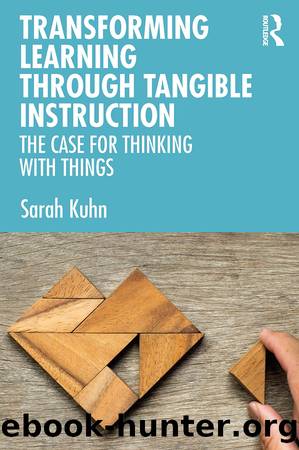Transforming Learning Through Tangible Instruction: The Case for Thinking With Things by Sarah Kuhn

Author:Sarah Kuhn [Kuhn, Sarah]
Language: eng
Format: epub
ISBN: 9780367652708
Google: zDggzgEACAAJ
Publisher: Routledge
Published: 2021-11-15T00:22:00.827524+00:00
Interlude D: Qualitative Research Software
In this book, my focus has been on tangible things to think with, inhabiting space in the physical world. This is not to deny that digital things can be rich tools and provocations for deep thinking. My choice to focus on the non-digital world stems largely from the fact that, in education in the last generation or so, I feel we have leapfrogged over the physical and the analog and focused almost exclusively on the digital, to the detriment of the embodied learners we are trying to teach. Still, I donât want the digital world to be entirely absent from this book.
Perhaps the most famous example in education of a fruitful digital thing to think with is Seymour Papertâs Logo. Logo is a simple, child-friendly programming language which in its early incarnations was paired with a robotic âturtleâ that could be commanded by children by way of the computer-based instructions they wrote. Papertâs work (for example his 1980 book Mindstorms1) has had an enormous impact on the education community, demonstrating how in capable hands the computer can be a site of deep learning, not just training on how to use software and the Internet. Countless educators and innovators have created curricula and new digital systems, like the products Lego Mindstorms and Scratch visual programming, inspired by Papertâs insights.
A quite different example from the world of higher education is my and my colleaguesâ experience with software called âNVivo.â NVivo is a tool used by scholars who are conducting qualitative researchâthat is, who are working with non-numerical data such as interview transcripts, memoranda, reports, and images. The academy has long used computers to analyze numerical data and has had associated software tools to conduct statistical analyses on numerical data sets large and small. Qualitative research, on the other hand, has until recently been conducted using paper records. A qualitative researcher, even a doctoral student, might have paper records filling multiple file cabinets, with interview transcripts, field notes, documents from the community being studied, paper forms demonstrating the informed consent of the human subjects who participated in the study, and so on. When the researcher starts to code these documents (by highlighting passages that are associated with particular topics), the amount of paper proliferates further. And as part of the analysis of the data, the documents were often cut up and sorted by the code with which they were associated, in order to begin to see patterns in the data, a key step in analysis.
With NVivo and other qualitative research software, all this work is performed on digital documents. Suddenly, student work can be carried on a memory stick or posted to a class web site. In the days of paper, professors and fellow students would be unlikely to look through drawers of filing cabinets to see the raw material of a studentâs project; now that material can be visible and easily explored. Students can get more relevant and thorough feedback from their peers and their instructors, and can use the software to explore questions about their data easily and in real time.
Download
This site does not store any files on its server. We only index and link to content provided by other sites. Please contact the content providers to delete copyright contents if any and email us, we'll remove relevant links or contents immediately.
Navigation and Map Reading by K Andrew(5111)
Spare by Prince Harry The Duke of Sussex(5072)
Tuesdays with Morrie by Mitch Albom(4692)
Cracking the GRE Premium Edition with 6 Practice Tests, 2015 (Graduate School Test Preparation) by Princeton Review(4224)
Machine Learning at Scale with H2O by Gregory Keys | David Whiting(4180)
Never by Ken Follett(3791)
Goodbye Paradise(3728)
What It Really Takes to Get Into Ivy League and Other Highly Selective Colleges by Hughes Chuck(3696)
Harry Potter and the Prisoner of Azkaban (Book 3) by J. K. Rowling(3304)
Fairy Tale by Stephen King(3220)
Pledged by Alexandra Robbins(3132)
Kick Ass in College: Highest Rated "How to Study in College" Book | 77 Ninja Study Skills Tips and Career Strategies | Motivational for College Students: A Guerrilla Guide to College Success by Fox Gunnar(3075)
A Dictionary of Sociology by Unknown(3031)
Sapiens and Homo Deus by Yuval Noah Harari(2987)
Reminders of Him: A Novel by Colleen Hoover(2951)
The Social Psychology of Inequality by Unknown(2940)
Graduate Admissions Essays, Fourth Edition: Write Your Way into the Graduate School of Your Choice (Graduate Admissions Essays: Write Your Way Into the) by Asher Donald(2876)
Will by Will Smith(2793)
Zero to Make by David Lang(2726)
